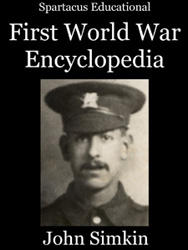William Bishop
William Bishop was born in Owen Sound, Ontario in 1894. He joined the Canadian Expeditionary Force in 1914 and the following year transferred to the Royal Flying Corps.
Initially considered a mediocre his extraordinary eyesight and his willingness to practice, turned him to one of the outstanding flyers of the First World War. Promoted to commander of the Flying Foxes, he was awarded the Distinguished Flying Cross (DFC) for scoring 25 victories in twelve days. On 2nd June 1917 he won the Victoria Cross after a single-handed attack on a German aerodrome near Vimy Ridge. During the war Bishop wrote Winged Warfare, an autobiographical account of his experiences as a pilot.
By the time the First World War ended Bishop was able to claim 72 victories. Only Manfred von Richthofen (80), Rene Fonck (75) and Mick Mannock (73) had better records.
After the war Bishop became the first Canadian Air Marshall and throughout the Second World War was director of the Royal Canadian Air Force.
William Bishop died in 1956.
Primary Sources
(1) The London Gazette (11th August, 1917)
Captain Bishop, who was sent out to work independently, flew to an enemy aerodrome at least 12 miles the other side of the line. Seven machines, some with their engines running, were on the ground. He attacked these from about fifty feet, and a mechanic, who was starting one of the engines, was seen to fall. One of the machines got off the ground, but at the height of 60 feet, Captain Bishop fired 15 rounds into it at very close range, and it crashed to the ground. A second machine got off the ground, into which he fired 30 rounds at 150 yards range, and it fell into a tree. Two more machines then rose from the aerodrome. One of these he engaged at a height of 1,000 feet, emptying the rest of the drum of ammunition. This machine crashed 300 yards from the aerodrome, after which Captain Bishop emptied a whole drum into the fourth hostile machine, and then flew back to his station.
(2) William Bishop, Winged Warfare, (1918).
I was flying over a layer of white clouds when I saw a two-seater just above me. This German machine was all alone. Neither the pilot nor the observer saw me. They flew along blissfully ignorant of my existence, while I kept carefully underneath them. I was only ten yards behind the Hun when I fired directly up at him. Although I managed to fire ten rounds I did not hit anything vital. I dived at him, firing as I came. The German observer shot at me with his swivel gun. I could now see my own bullets hitting the right part of the Hun machine. It burst into flames. A second later it fell a burning mass, leaving a long trail of smoke behind as it disappeared through the clouds.
While I have no desire to make myself appear as a blood-thirsty person. I must say that to see an enemy going down in flames is a source of great satisfaction. You know his destruction is absolutely certain. The moment you see the fire break out you know that nothing in the world can save the man, or men, in the doomed aeroplane. I flew away with great contentment in my heart.

